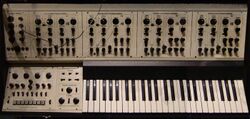Engineering:Oberheim polyphonic
| FVS-1 | |
|---|---|
 Oberheim Four Voice | |
| Manufacturer | Oberheim |
| Dates | 1975–79 |
| Price | US$4,295 ($5,690 with programmer module) |
| Technical specifications | |
| Polyphony | 4 voice |
| Timbrality | Multitimbral |
| Oscillator | 2 VCOs per voice with sawtooth or variable-pulse waveforms |
| LFO | 1 with triangle wave |
| Synthesis type | Analog Subtractive |
| Filter | Low, band, high, notch filter w/ resonance |
| Attenuator | 2 x ADR envelopes |
| Aftertouch expression | No |
| Velocity expression | No |
| Storage memory | 16 patches via programmer module |
| Effects | None |
| Input/output | |
| Keyboard | 49-key |
| External control | CV/Gate |
The Oberheim polyphonic is an analog music synthesizer that was produced from 1975 to 1979 by Oberheim Electronics. It was developed by Tom Oberheim, and was the first production synthesizer capable of playing chords.
Specification
Oberheim took the idea and electronics of a Minimoog synthesizer and put them in a small box, making a few changes, and produced the SEM (synthesizer expansion module), which became the building block of his polyphonic synths. By strapping two, four, or eight of these SEMs together under keyboard control, he was able to create practical, albeit large, synthesizers that could play two, four, or eight notes simultaneously. Oberheim polyphonic was born. Each SEM in an Oberheim polyphonic generates one voice (or note).
The four- and 8-voice models included a "preset programmer" which allowed the user to store and recall most sound settings, and you could glide from one note or chord to another using portamento.
The Oberheim polyphonic was later outdated by a new line of microprocessor-controlled Oberheim synthesizers, beginning with the OB-X. The OB-X was fully programmable and significantly more compact than the Oberheim polyphonic.
Despite their maintenance cost and rarity, Oberheim polyphonic synthesizers are still adored by many musicians today for their characteristic sonic 'thickness' and 'depth' caused in part by the random variance between each SEM module.
exhibited at Musical Instrument Museum (Phoenix)
Notable users
- 808 State
- Blue Weaver / Bee Gees
- Bob James
- The Brothers Johnson
- Chick Corea
- Dave Grusin
- Depeche Mode
- Fleetwood Mac
- Gary Wright
- George Duke
- Goldfrapp
- Herbie Hancock
- Jean Michel Jarre
- Joe Zawinul / Weather Report
- John Carpenter
- Larry Dunn / Earth, Wind & Fire
- Lyle Mays
- Michael McDonald / Doobie Brothers
- Prince
- Patrick Moraz
- Paul Kantner / Jefferson Starship
- Pete Namlook
- Pink Floyd
- Rose Royce
- Rufus
- Geddy Lee / Rush
- Ryuichi Sakamoto
- Stevie Wonder
- The Stranglers
- Styx
- Supertramp
- Tangerine Dream
- The Shamen
- Trent Reznor
- Vangelis
- Vince Clarke
- Yellow Magic Orchestra
See also
- Polyphonic synthesizer
References
- ↑ "Custom Oberheim 8 voice". SynthFool.com. http://www.synthfool.com/moraz/. — One of six made. Patrick Moraz once owned other one.
External links
- Two Voice at Vintage Synth Explorer
- Four Voice at Vintage Synth Explorer
- Eight Voice at Vintage Synth Explorer




